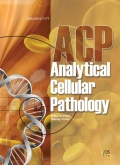Authors: Ploeger, Lennert S. | Beliën, Jeroen A.M. | Poulin, Neal M. | Grizzle, William | Diest, Paul J. van
Article Type:
Research Article
Abstract:
Background: Confocal Laser Scanning Microscopy (CLSM) provides the opportunity to perform 3D DNA content measurements on intact cells in thick histological sections. So far, sample size has been limited by the time consuming nature of the technology. Since the power of DNA histograms to resolve different stemlines depends on both the sample size and the coefficient of variation (CV) of histogram peaks, interpretation of 3D CLSM DNA histograms might be hampered by both a small sample size and a large CV. The aim of this study was to analyze the required CV for 3D CLSM DNA histograms given a realistic
…sample size. Methods: By computer simulation, virtual histograms were composed for sample sizes of 20000, 10000, 5000, 1000, and 273 cells and CVs of 30, 25, 20, 15, 10 and 5%. By visual inspection, the histogram quality with respect to resolution of G0/1 and G2/M peaks of a diploid stemline was assessed. Results: As expected, the interpretability of DNA histograms deteriorated with decreasing sample sizes and higher CVs. For CVs of 15% and lower, a clearly bimodal peak pattern with well distinguishable G0/1 and G2/M peaks were still seen at a sample size of 273 cells, which is our current average sample size with 3D CLSM DNA cytometry. Conclusions: For unambiguous interpretation of DNA histograms obtained using 3D CLSM, a CV of at most 15% is tolerable at currently achievable sample sizes. To resolve smaller near diploid stemlines, a CV of 10% or better should be aimed at. With currently available 3D imaging technology, this CV is achievable.
Show more
Keywords: Confocal laser scanning microscopy, DNA ploidy, histogram quality, sample size, computer simulation
Citation: Analytical Cellular Pathology,
vol. 26, no. 3, pp. 93-99, 2004
Price: EUR 27.50





